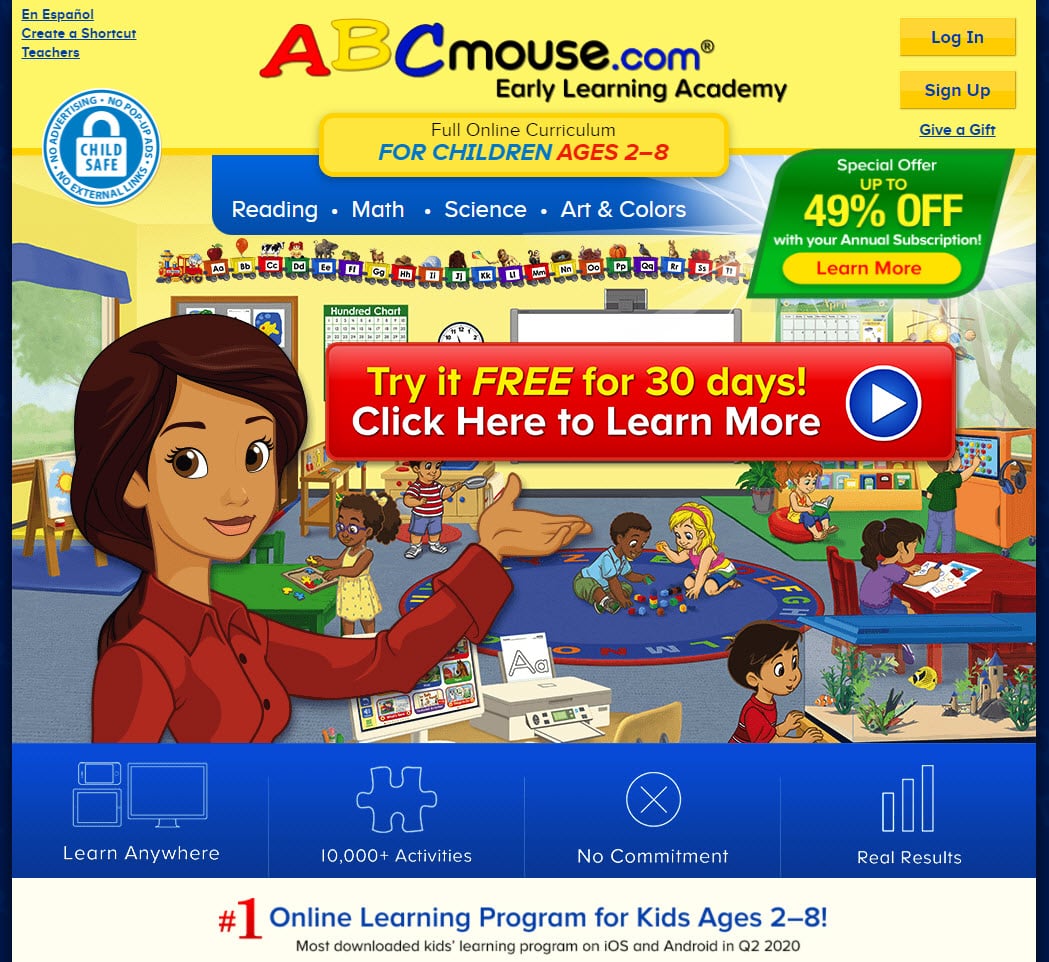Reading Tips for Parents of 1st Graders: Help Your Kids Become Better Readers
Reading is one of the most essential skills your first grader can learn, and it starts early.
But it doesn’t have to be complicated!
This post will show you our top 13 reading tips for parents of first graders, so you can help your child become a better reader without feeling overwhelmed.

Best Rated
See the Best Rated Reading Program
Take Quiz
Discover the ideal reading program for you & your child
Read this article
Continue reading the article
Reading tips for first-grade parents
1. Have patience
When children are learning to read, it’s vital for you as the parent to be patient.
It takes time and practice to master reading.
If parents get frustrated or impatient, it can discourage the child and cause them to give up on learning to read altogether.
Remember, some kids struggle with reading because they need more time and practice. This can be frustrating for both you and your child, but it’s essential to be patient and keep practicing a little every day.
This is probably the most important tip on this list.
Reading should be fun, exploratory, and educational for children and parents!
2. Invest in an at-home learn to read program
Phonemic awareness and phonics are essential skills that children need to be successful readers.
These skills help children understand language, which is critical for reading. Without phonemic awareness and phonics, children will struggle to decode words and will have difficulty reading.
The best reading programs for first-graders are based on the science of reading can help a child learn to read more easily.
With a program that focuses on phonics and phonemic awareness, parents can see an improvement in their child’s reading skills in a shorter amount of time.
Phonics instruction should be systematic and explicit.
This means that the instruction must be consistent and follow a specific order. Phonics instruction is one of the most critical aspects of reading education. It teaches children the letters and sounds that makeup words.
Children who cannot master phonics are more likely to struggle with reading throughout their school career. The program should also be tailored to the child’s individual needs so they can progress at their own pace.
Children Learning Reading is a step-by-step phonics and phonemic awareness program designed to help parents teach their kids explicit reading instruction at home. The program starts with letter sounds and progresses to blending those sounds together to read words, sentences, and stories.
It’s a great way to ensure your child gets explicit, systematic instruction in reading. The program teaches phonemic awareness, phonics, fluency, vocabulary, and comprehension skills.
3. Read to your child consistently
One of the most important ways you can help your child become a better reader is to read to them daily.
It’s sad to see that this is one of the most neglected activities, even though it has many benefits.
Research shows that doing so can help improve your child’s listening skills, vocabulary, and literacy abilities.
Your little one will become more engaged with reading if they hear stories read aloud regularly. Because reading aloud to your children is an enjoyable experience that will help them develop a love for books.
It’s also a bonding experience for parents and children that should be cherished.
Reading aloud to your children is one of the simplest and most important things you can do to help them develop a love for reading.
Ultimately, children who are read to daily by their parents become more confident and independent readers in first grade.
4. Lead the way
It’s also important to remember that as a first-grade parent, you should set an example for your child by reading and writing regularly.
Your children are always watching you.
They will be more likely to read if they see that you, as an adult, also enjoy reading.
When you read books, newspapers, or magazines in front of them, they learn the importance of reading and writing. Make a concerted effort to read for at least a few minutes each day in front of your children, even if it’s just while you’re waiting for dinner to cook.
Additionally, let them know that reading is not just a child’s activity. Adults must also read to stay informed and up-to-date on the world around them.
If you want your child to learn how to read and write successfully, be sure to model these behaviors yourself!
5. Look around
One way to help your child identify letters in natural settings is to encourage them to spot common letters, pictures, and words on posters, billboards, road signs, etc.
One way to help your child with reading skills is to encourage them to identify letters in their day-to-day lives.
This can be done by pointing out the common letters and words on billboards, road signs, and food packaging in the grocery store.
You can identify letters in natural settings anywhere you go. Even if you’re just out and about running errands, take a moment to find letters in your environment. You can even try to find as many letters as you can in a short amount of time.
But always keep it light and fun; don’t pressure your child or make it feel like a chore.
6. Go online
Using online reading apps in your reading routine can help children develop an interest in reading.
You can use word and letter games on your tablet to improve multisensory practice.
Today, online reading apps can help parents track their child’s reading progress and keep them engaged in learning. There is a range of online reading program apps that can be a great complement to first-grade reading development.
Programs like ABC Mouse and Reading Eggs offer different reading material levels and activities to help children develop their literacy skills. These tools can help make learning more fun for your child and encourage them to continue progressing academically.
7. Ask questions
First-grade parents must engage their children in conversation about the book they are reading.
This helps the child develop a deeper understanding of the material and encourages critical thinking skills.
Asking questions during reading also makes the experience more engaging for children.
It’s a great way to help your child understand the story better. Not only will this help with their literacy, but it will also help them develop communication skills.
8. Get the whole family to talk a lot
You may not realize it, but when families are talking to a first-grade child daily, they are helping them improve their reading skills.
Just by using interesting words and building on past conversations, you are allowing them to learn new words and concepts. Talking also has invaluable benefits beyond learning to read. It helps to build trust and communication between you and your child. You can discuss school work and upcoming events or just chat about their day.
Talking regularly will help keep your child feel connected to you and give you a better understanding of what’s going on in their lives.
So keep up the good work, and keep talking!
9. Games and activities involving words
Many fun family activities can stimulate a child’s interest in reading.
One fun way to help your child learn to read and spell words is to play sight word games. There are many different types of these games. Still, they all involve having your child identify and spell words on a screen or written out on a card. Regularly playing these games will help your child learn common sight words.
Playing word games is a great way to help your children develop their vocabulary. By playing these games, your children will learn new words and how they are used in a sentence. This will not only help them with their reading skills but also with their grammar skills.
Games like Hangman, Scrabble, and Boggle are all great for vocabulary development and can help improve reading comprehension skills.
Playing word games is also a fantastic way to foster a love of reading in your children.
10. Choose books appropriate to your child’s level
When selecting books for your child, choosing titles at the right reading level is essential.
This will ensure they understand what they are reading and make the most of their reading experience.
If the book is too difficult, your child will become discouraged and may not want to read anymore. On the other hand, if the book is too easy, your child will become bored quickly. Try to find books that are interesting and challenging without being overwhelming.
This will help to improve their reading skills and give them a secure foundation for a lifelong love of reading.
11. Reread, Reread, Reread
It is essential to encourage your child to reread favorite books and stories because it helps improve their reading skills.
Kids need to read a text multiple times to understand it better. Rereading helps them read more quickly and accurately and allows them to overcome specific words or phrases they may have stumbled on the first time. This repetition builds reading fluency.
12. Positivity and enthusiasm
Be positive and enthusiastic about your children’s reading development- this will encourage them to become great readers!
Let them see you reading for pleasure and talk about your favorite books.
When they have questions about a book or are stuck on a word, take the time to help them. Praise them when they sound out a problematic word, self-correct or ask questions while reading.
If you correct every mistake they make, they will become discouraged and frustrated. Praise them instead for the right things they do and help them learn from their mistakes.
They’ll appreciate your support, which will help foster a love of reading in your child and encourage them to keep practicing.
13. Reading should always be fun
Reading together is a great way to spend time with your children and help them learn simultaneously.
It can be a fun bonding activity, and it’s also vital for first-grade parents to make reading a daily routine. This will help children to understand that reading is an integral part of the day.
It is crucial to make the reading time enjoyable and interactive for the child.
Reading time should be a conversation between you and your child, where your little one can ask questions and participate in the story. This will help foster a love of reading in the child and make learning easier.
Even when your child is at a stage where they can read on their own, it’s still enjoyable to read with them. You can take turns reading chapters or pages and discuss the story afterward.
Continue to make time every day for reading together, and enjoy the special connection that comes from sharing a good book.
How to help your first grader with reading comprehension
Highlighting the central theme
Every story has a central theme. Ask your child what they think the most important part of the story is and why. This will help them to understand and remember the story better.
Understanding sequencing
Sequencing is the order in which a story is told. Kid’s books often use chronology to help young children understand time and events.
First graders need to understand sequencing so they can understand story structure. Sequencing helps children practice story structure and understand the plot.
Sequencing can be practiced when your child retells the story and sorts flashcards with different points in the story.
This skill can be practiced in several ways. One way is to have your child retell the story. Additionally, you can have them sort flashcards based on different points in the story. With practice, your child can sequence stories quickly and understand how a story unfolds.
Draw conclusions
Drawing conclusions is a way of understanding information by putting together different pieces of evidence to form a logical guess. To help your first grader with reading comprehension, you can encourage them to predict what happens next in the story.
Repetition
One way to help your first grader with reading comprehension is through repetition.
Reading the same story multiple times will make them more familiar with the words and their meanings. As a result, they will be able to read the story more fluently without spending as much focus on sounding out each word.
This will allow them to focus on the meaning behind the words and the story itself.
It has been found that repetition helps children understand new stories better.
This is because they can process the information more thoroughly and remember it for a more extended period. As a parent, you can help your child with reading comprehension by reading to them frequently and repeating key points from the story.
Verbal processing
When you are reading with your first grader, help them to process the story verbally.
This means talking about what is happening in the story, making connections between events, and helping them to remember critical details. This will improve their reading comprehension and focus.
Five finger strategies
The five-finger strategy is a great way to help your first grader with reading comprehension.
You break down the story into five parts and use your fingers to represent each part.
- The first finger is for the setting: Where is the story taking place.
- The second is for characters: Who is in the story.
- The third is for events: What happens in the story.
- The fourth is for the end: How does the story end.
- And the fifth is for favorite: What is your favorite part of the story.
This helps your child visualize what was happening in the story and remember key points.
Ask questions
When you are reading with your child, stop periodically to ask questions about the text.
This will help improve their comprehension by forcing them to think about what they have read. If they have difficulty understanding a particular word or concept, you can use questioning to help them figure it out.
You can encourage your little one to be an active reader who is constantly engaged with the text by asking questions.
Questioning is an effective strategy that helps make predictions about the text, understand difficult words or parts of the text, and infer meaning from what is read. It can be done before, during, and after reading.
By questioning what they are reading, children can better understand it.
Processing
Processing is a term used to describe how our brains take in and make sense of information.
When we read, our brains constantly process the words on the page, trying to understand their meaning.
If we are not actively engaged in reading, our brains can quickly become bored or confused, and we may not comprehend what we have read. This is why it is so important to help your first grader with reading comprehension.
You can ensure that your child truly understands the text by pausing every few pages to check in and ask questions. If they are not, you can help them get back on track by clarifying the meaning of the words or passages in question.
Ultimately, by modeling good comprehension skills yourself, you will help your child develop into a strong reader.
What are the expectations of 1st-grade readers?
1st grade is an essential year for reading development.
During this time, students will learn to read with fluency and comprehension. They will also develop skills in vocabulary, grammar, and writing.
Here are the most crucial reading skills a first grader will develop.
Phonological Awareness
Phonological awareness is vital for first-grade reading because it helps children understand the smallest parts of sound in words.
When children hear the sounds in words, they can better understand what the word means.
Phonological awareness also helps children learn to read and spell words.
Print Concepts
Print concepts are the basic rules of how to read a text.
They include understanding that print goes from left to right and top to bottom, that words are separated by spaces, and that punctuation marks show how a sentence should be read. Print concepts are important for first-grade reading because they provide a foundation for understanding how to read a text.
Phonics
Phonics is the relationship between letters and sounds.
It helps children decode unfamiliar words correctly and consistently. At the 1st-grade reading level, children are expected to use phonics to decode phonetically regular words. Phonics is the process of teaching children the sounds individual printed letters and groups of letters make.
Phonics helps children to recognize familiar words accurately and automatically. It also helps them to “decode” new words.
Phonics is important for reading fluently and understanding what is being read.
Fluency
Reading fluency is the ability to read text accurately and quickly.
Fluent readers do not have to stop and sound out words; they can automatically recognize most words.
Fluency is important because it is closely related to reading comprehension. When readers are fluent, they can focus on understanding the content of what they are reading rather than decoding individual words.
There are many ways that parents and teachers can help children develop reading fluency:
- Read aloud frequently to children. This exposes them to a wide variety of books and helps them develop an ear for language.
- Have children read aloud frequently. This gives them practice with reading aloud with expression and helps them build confidence as readers.
- Encourage children to reread familiar books. This allows them to practice automatic word recognition and improve their fluency skills
Vocabulary
Vocabulary is a critical component of reading comprehension, as it allows readers to understand the meaning of new or unfamiliar words.
A rich vocabulary will also enable readers to better connect with what they are reading, making the experience more enjoyable.
For children to build and expand their knowledge of words, they need to be actively engaged in the learning process. This means reading the words around the main word, guessing their meaning, and then checking in a dictionary to see if they were right.
It’s essential to make this a fun activity for your child, so be sure to read together and discuss the meanings of the words you encounter.
Comprehension
Comprehension is the ability to understand and remember what is read.
It is a fundamental goal for 1st-grade reading because it helps students control their reading, become purposeful readers, and know what they are reading.
What role do families play in the process?
Parents, grandparents and older siblings all play a crucial role in the reading process.
They can help their first-graders become better readers by encouraging them to read at home daily and stay involved in their educational experiences. Parents can also stay informed about early literacy by reading articles and attending workshops.
How do you teach a parent to read to their little one?
There is no need for a parent to first learn how to teach before helping their child read.
It’s about having the right attitude and following a step-by-step reading program at home.
Bringing a positive attitude, patience, and commitment to consistency are the most important things a parent needs when teaching their child to read. If a parent is patient and makes time for their child to read daily, the child will consistently improve their reading skills.
You can help your first grader become a better reader in many different ways.
The most important thing is to ensure reading is a part of your daily routine. Try some tips in this post and see how your child’s reading skills improve. And if you’re looking for more help, check out our post on recommended reading programs for kids.

Natalie is a full-time blogger and former elementary school teacher who specializes in helping parents teach their kids to read. With a qualification in Early Childhood Education, over 7 years of experience in education, and a passion for literacy, Natalie provides practical tips, activities, and resources for parents looking to support their child’s learning-to-read journey. She is the proud mom of two young readers and loves sharing her knowledge and experience with other parents. Natalie enjoys spending time with her family, reading, and exploring the great outdoors when she’s not blogging.


















